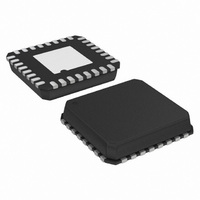AD8193ACPZ-R7 Analog Devices Inc, AD8193ACPZ-R7 Datasheet - Page 13

AD8193ACPZ-R7
Manufacturer Part Number
AD8193ACPZ-R7
Description
IC,Telecom Switching Circuit,LLCC,32PIN,PLASTIC
Manufacturer
Analog Devices Inc
Datasheet
1.AD8193ACPZ-R7.pdf
(16 pages)
Specifications of AD8193ACPZ-R7
Function
Switch
Circuit
1 x 2:1
Voltage Supply Source
Single Supply
Voltage - Supply, Single/dual (±)
3 V ~ 3.6 V
Current - Supply
50mA
Operating Temperature
-40°C ~ 85°C
Mounting Type
Surface Mount
Package / Case
32-LFCSP
Lead Free Status / RoHS Status
Lead free / RoHS Compliant
Auxiliary Control Signals
There are four single-ended control signals associated with each
source or sink in an HDMI/DVI application. These are hot plug
detect (HPD), consumer electronics control (CEC), and two
display data channel (DDC) lines. The two signals on the DDC
bus are SDA and SCL (serial data and serial clock, respectively).
The AD8193, which is a low cost part, does not have any
additional capability to switch these signals; other means are
required to switch these signals if required.
In general, it is sufficient to route each auxiliary signal as a
single-ended trace. These signals are not sensitive to impedance
discontinuities, do not require a reference plane, and can be
routed on multiple layers of the PCB. However, it is best to
follow strict layout practices whenever possible to prevent the
PCB design from affecting the overall application. The specific
routing of the HPD, CEC, and DDC lines depends upon the
application in which the AD8193 is being used.
For example, the maximum speed of signals present on the
auxiliary lines is 100 kHz I
any layout that enables 100 kHz I
bus should suffice. The HDMI 1.3 specification, however, places
a strict 50 pF limit on the amount of capacitance that can be
measured on either SDA or SCL at the HDMI input connector.
This 50 pF limit includes the HDMI connector, the PCB, the
capacitance of the CMOS switch, and whatever capacitance is
seen at the input of the HDMI receiver. There is a similar limit
of 100 pF of input capacitance for the CEC line.
The parasitic capacitance of traces on a PCB increases with
trace length. To help ensure that a design satisfies the HDMI
specification, the length of the CEC and DDC lines on the PCB
should be made as short as possible. Additionally, if there is a
reference plane in the layer adjacent to the auxiliary traces in
the PCB stackup, relieving or clearing out this reference plane
immediately under the auxiliary traces significantly decreases
the amount of parasitic trace capacitance. An example of the
board stackup is shown in Figure 22.
SILKSCREEN
LAYER 1: SIGNAL (MICROSTRIP)
PCB DIELECTRIC
LAYER 2: GND (REFERENCE PLANE)
PCB DIELECTRIC
LAYER 3: PWR (REFERENCE PLANE)
PCB DIELECTRIC
LAYER 4: SIGNAL (MICROSTRIP)
SILKSCREEN
Figure 22. Example Board Stackup
2
C data on the DDC lines; therefore,
2
C to be passed over the DDC
3W
RELIEVED UNDERNEATH
REFERENCE LAYER
MICROSTRIP
W
3W
Rev. 0 | Page 13 of 16
HPD is a dc signal presented by a sink to a source to indicate
that the source EDID is available for reading. The placement
of this signal is not critical, but it should be routed as directly
as possible.
Power Supplies
The AD8193 has three separate power supplies referenced to
a single ground. The supply/ground pairs are
•
•
•
The AVCC/AVEE (3.3 V) supply powers the core of the
AD8193. The VTTI/AVEE supply (3.3 V) powers the input
termination (see Figure 19). Similarly, the VTTO/AVEE
supply (3.3 V) powers the output termination (see Figure 20).
In a typical application, all pins labeled AVEE should be con-
nected directly to ground. All pins labeled AVCC, VTTI, or
VTTO should be connected to 3.3 V. The supplies can also be
powered individually, but care must be taken to ensure that
each stage of the AD8193 is powered correctly.
Power Supply Bypassing
The AD8193 requires minimal supply bypassing. When
powering the supplies individually, place a 0.01 μF capacitor
between each 3.3 V supply pin (AVCC, VTTI, and VTTO) and
ground to filter out supply noise. Generally, bypass capacitors
should be placed near the power pins and should connect directly
to the relevant supplies (without long intervening traces). For
example, to minimize the parasitic inductance of the power
supply decoupling capacitors, minimize the trace length between
capacitor landing pads and the vias as shown in Figure 23.
In applications where the AD8193 is powered by a single 3.3 V
supply, it is recommended to use two reference supply planes
and bypass the 3.3 V reference plane to the ground reference
plane with one 220 pF, one 1000 pF, two 0.01 μF, and one 4.7 μF
capacitors. The capacitors should via down directly to the supply
planes and be placed within a few centimeters of the AD8193.
AVCC/AVEE
VTTI/AVEE
VTTO/AVEE
Figure 23. Recommended Pad Outline for Bypass Capacitors
RECOMMENDED
NOT RECOMMENDED
EXTRA ADDED INDUCTANCE
AD8193








